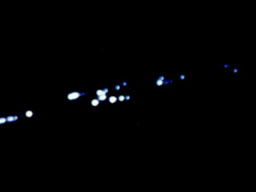




Life In Deep Space
|
What
about life in deep space, for instance on comets and asteroids,
or even on meteorites? Comets, |
|||||||||||||||||||||
|
Comets
One of the most fundamental questions about the origins of life on Earth was revived in the public's mind in the late 1970's, by the astronomers Professor Sir Fred Hoyle of Cambridge University, in England, and Professor Chandra Wickramasinghe, of Cardiff University in Wales. They published a highly controversial paper in The New Scientist magazine. It revived Lord Kelvin's ideas from more than a hundred years previously by suggesting that perhaps life had not begun on Earth at all, but had been seeded to Earth by comet and asteroid impact. The theory is now known as Panspermia. |
|||||||||||||||||||||
|
If this idea was not sufficiently debatable, they went on enrage many scientists by suggesting that influenza viruses originated in the ice of comets and the meteor streams left by comet tails. Their case was unconvincing to many who read the article, but the Panspermia idea had taken seed. Others thought about it, not least the world's space agencies, and while almost no-one accepted the notion of "Space Flu", the overall concept did not seen as far-fetched as it had done before the Russian and NASA missions to other planets in the Solar System, which had started in the mid 1960's. This was not surprising for other people had been thinking along similar lines, but had not attracted the public attention nor the wrath of their fellow scientists. One of the earliest was Juan Oró of Houston University, in 1961 and Sherwood Chang at NASA Ames, in 1979. More recently Christopher Chyba of the SETI Institute has been a keen advocate of Panspermia. Comets (Visit: Comets Home from University of Hawaii) are now accepted to be good candidates as life-carriers in the form of micro-organisms such as bacteria or viruses. They have many of the right ingredients - organic compounds, carbon, water, and perhaps they can become warm enough to allow carbon life processes to start to work. |
|||||||||||||||||||||
|
The icy fragments of the Schumaker-Levy 9 Comet that hit Jupiter in 1994 © NASA, 1994 When a planetary system forms, hundreds of billions of comets (See Kuiper Belt Objects) condense from the hot dusty debris and gas that is the raw material for their formation. Most of these occupy the dark, cold outer regions. The comets are composed of ice, rocky material such as silicates and a cocktail of elementary chemicals - eg carbon, Sulfur, phosphorus - and simple compounds - eg ammonia, methane. At
the time of cometry formation the temperatures inside a forming
comet may be are high enough to permit chemical reactions to occur
at a rapid rate and even, perhaps for water to be liquid.
If this is the case, then the conditions and basic chemicals of
life could exist inside a comet. Recent experiments
and discoveries by teams of researchers such as the Laboratory
Astrophysics Group, at NASA Ames, suggest that life might
just be able to come into being in such conditions. And
if this is so, then it is likely that the life that forms is bacterial
or archaean in nature |
|||||||||||||||||||||
|
Not only do comets appear to contain the ingredients for life, they also contain the nutrients to allow replication and multiplication, so that a comet might even be largely made up living entities! In fact, it has been discovered that the infrared signatures of comets, including Hale-Bopp and Halley, are identical to that of bacteria. But we should not accept this as certain proof, for other materials have the same signature. Slightly more convincing evidence comes from watching meteor trails. Conditions in a comet might at first sight appear too extreme for life. Low temperatures and pressures and high levels of radiation should mitigate against the survival of life. Many, if not most microbes on Earth live in extreme conditions, however. Survival in space should be no problem for suitably adapted organisms. The truth about cometry habitats, however, will not be answered until we have examined at least one comet at close hand. NASA, ESA and NASDA are all working on comet rendezvous projects, to retrieve samples of material for analysis. Within the next decade, some of the most important questions in the interstellar life debate may have been answered. |
|||||||||||||||||||||
|
|
|||||||||||||||||||||
Go
to
Home
| Space Station
| Mars | Rainforest
© 1999 Satellite Events Enterprises Inc.

